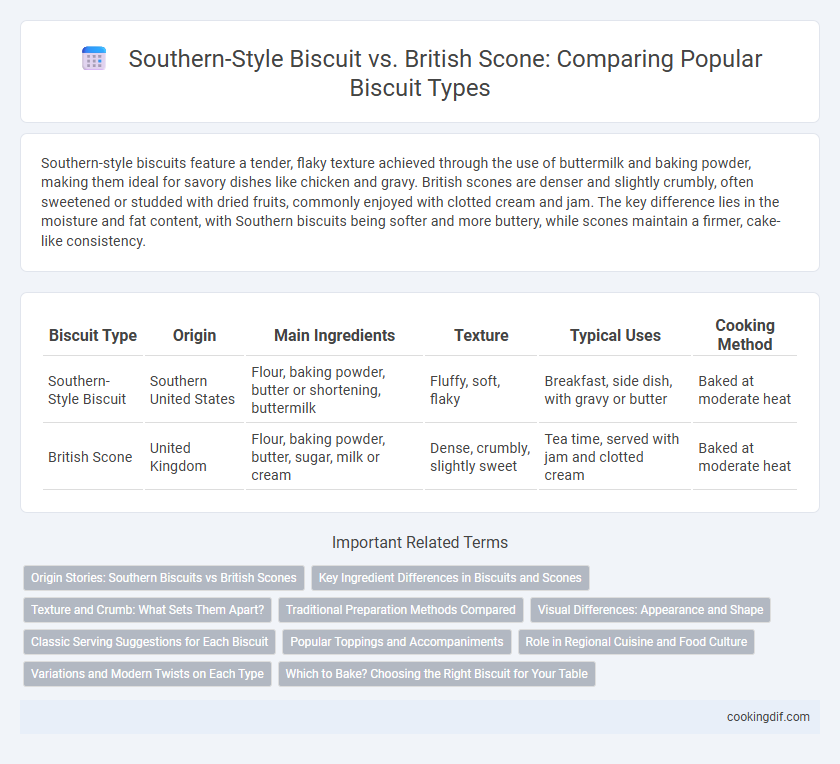Southern-style biscuits feature a tender, flaky texture achieved through the use of buttermilk and baking powder, making them ideal for savory dishes like chicken and gravy. British scones are denser and slightly crumbly, often sweetened or studded with dried fruits, commonly enjoyed with clotted cream and jam. The key difference lies in the moisture and fat content, with Southern biscuits being softer and more buttery, while scones maintain a firmer, cake-like consistency.
Table of Comparison
| Biscuit Type | Origin | Main Ingredients | Texture | Typical Uses | Cooking Method |
|---|---|---|---|---|---|
| Southern-Style Biscuit | Southern United States | Flour, baking powder, butter or shortening, buttermilk | Fluffy, soft, flaky | Breakfast, side dish, with gravy or butter | Baked at moderate heat |
| British Scone | United Kingdom | Flour, baking powder, butter, sugar, milk or cream | Dense, crumbly, slightly sweet | Tea time, served with jam and clotted cream | Baked at moderate heat |
Origin Stories: Southern Biscuits vs British Scones
Southern-style biscuits trace their origins to early American settlers, combining European baking techniques with local ingredients, resulting in a flaky, buttery bread often served with savory dishes. British scones, rooted in Scottish tradition, began as a simple oat-based quick bread cooked on a griddle, evolving into a slightly sweet, crumbly treat commonly paired with clotted cream and jam. Despite their shared classification as biscuits in their respective regions, Southern biscuits prioritize a soft, airy texture while British scones emphasize a denser crumb and subtle sweetness.
Key Ingredient Differences in Biscuits and Scones
Southern-style biscuits rely on buttermilk and baking powder as key ingredients, creating a tender, flaky texture with a slight tang. British scones often use cream and baking soda or baking powder, resulting in a denser, crumbly texture that is less tangy and slightly sweeter. The fat used in Southern biscuits is typically solid shortening or butter, enhancing flakiness, while scones incorporate cold butter cut into the flour for a crumbly consistency.
Texture and Crumb: What Sets Them Apart?
Southern-style biscuits feature a flaky, tender texture with a light, airy crumb achieved through the use of cold butter or shortening and buttermilk, creating distinct layers. British scones have a denser, crumbly texture with a tighter crumb due to the higher fat content and less liquid, often incorporating cream or milk. The key difference lies in the biscuit's flakiness versus the scone's rustic, crumbly structure, which impacts their respective mouthfeel and suitability for sweet or savory accompaniments.
Traditional Preparation Methods Compared
Southern-style biscuits are traditionally made using cold butter or shortening cut into flour, combined with buttermilk, and gently folded to create a flaky, tender texture. British scones typically incorporate sugar and cream or milk, with dough often mixed more thoroughly and rolled out before baking, resulting in a denser, crumbly consistency. The key difference lies in Southern biscuits relying on leavening agents like baking powder or soda for rise, while scones often use cream of tartar or self-raising flour, influencing their distinct texture and flavor profiles.
Visual Differences: Appearance and Shape
Southern-style biscuits feature a flaky, layered texture with a golden-brown crust and a round, slightly puffed shape, often showing distinct rise and separation of dough layers. British scones present a denser, crumbly texture with a pale, matte surface, typically topped with a light dusting of flour or sugar and shaped into a more uniform, flatter round or triangular form. Visual distinctions highlight the Southern biscuit's soft, airy look versus the scone's solid, rustic appearance.
Classic Serving Suggestions for Each Biscuit
Southern-style biscuits are traditionally served warm with butter, honey, or gravy, often accompanying fried chicken or breakfast dishes like eggs and sausage. British scones are commonly enjoyed split and spread with clotted cream and strawberry jam, typically paired with a pot of tea during afternoon tea service. Each biscuit type emphasizes complementary toppings that highlight regional culinary customs.
Popular Toppings and Accompaniments
Southern-style biscuits are often served warm with butter, honey, or sausage gravy, creating a savory and rich flavor profile favored in Southern American cuisine. British scones typically accompany clotted cream and strawberry jam, highlighting a sweet and creamy combination integral to traditional afternoon tea. Both biscuit types also pair well with tea or coffee, enhancing their distinct regional culinary experiences.
Role in Regional Cuisine and Food Culture
Southern-style biscuits, a staple in American Southern cuisine, are known for their flaky texture and buttery flavor, often served as a side dish or sandwich base. British scones, integral to traditional afternoon tea, are denser and sweeter, typically enjoyed with clotted cream and jam. Both hold cultural significance, with Southern biscuits embodying comfort food and community gatherings, while British scones represent a refined tea-time tradition.
Variations and Modern Twists on Each Type
Southern-style biscuits boast a flaky, buttery texture achieved through buttermilk and baking powder, often enhanced with modern twists like cheese, herbs, or chili flakes for savory appeal. British scones offer a denser crumb with a subtle sweetness, frequently incorporating dried fruits or flavored with citrus zest, and contemporary variations include gluten-free or vegan options with innovative fillings. Both biscuit types continue to evolve, reflecting regional tastes and dietary trends while preserving their iconic characteristics.
Which to Bake? Choosing the Right Biscuit for Your Table
Southern-style biscuits feature a flaky texture achieved through the use of buttermilk and baking powder, making them ideal for savory meals or breakfast sandwiches. British scones offer a denser crumb, often slightly sweetened and served with clotted cream and jam, perfect for afternoon tea or desserts. Selecting the right biscuit depends on the meal context: Southern biscuits complement hearty dishes, while scones cater to sweet, elegant occasions.
Southern-style biscuit vs British scone for biscuit type Infographic

 cookingdif.com
cookingdif.com